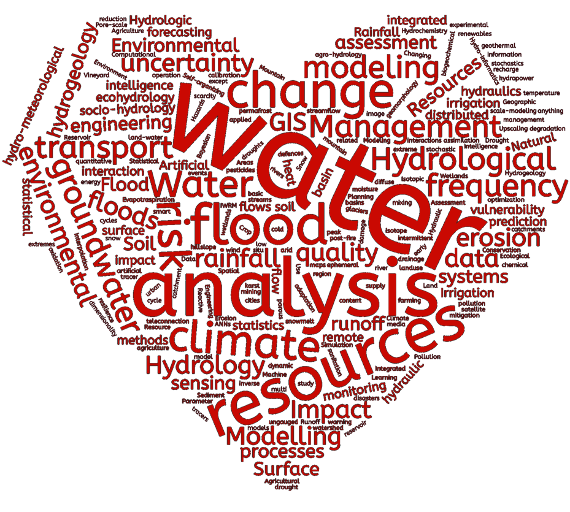Hydrological Sciences Journal DigestLatest articles & Journal updates | |
|---|
| | |
|---|
The latest news from HSJ
Welcome to HSJ Digest, our bi-monthly synopsis of the latest news from Hydrological Sciences Journal. Follow links to key Featured and Open Access articles, read our profile of Co-editor Professor Aldo Fiori, and find details of current Special Issues still open for submissions.
IAHS 2025 Scientific Assembly, Roorkee,
5–10 October
The HSJ Editorial Board of HSJ will hold an
in-person Editorial Retreat during the first two days of the Scientific Assembly in Roorkee, to share news and views about the Journal; an agenda will be formalized in due course.
Special Issues
Two recent Special Issues, ‘Twenty-first century hydrological challenges and opportunities in Africa’ and ‘History of hydrology’, have attracted a wealth of submissions, and the collections of published papers are growing daily. There is still time to submit to the History of hydrology, as well as to Contribution of isotope hydrology to water sciences in Africa and Advances in hydrological science in Latin America. | Openly in HSJ 
Open Access papers from recent issues
Issues 5 and 6 of HSJ contain several Open Access articles, among them Non-stationary frequency analysis of extreme rainfall events on the east coast of KwaZulu-Natal, South Africa, whose authors (Katelyn Johnson et al.) challenge the assumption of a stable climate, and investigate changing extreme rainfall on South Africa's east coast. While CO2 emerges as a significant factor, traditional stationary models surprisingly often outperform more complex, non-stationary approaches. | |
|---|
Co-editors’ choice
One article in every issue is singled out by the Co-editors to be featured for its excellence or innovation, and is awarded six months’ free access; in addition, the editors periodically choose an article of particular topical interest. Recent selections include the following:
Vol. 70 Issue 5
Featured article – free to view for six months
Improved streamflow simulations in hydrologically diverse basins using physically-informed deep learning models
Bhanu Magotra, Manabendra Saharia and C. T. Dhanya
By combining the power of deep learning with physical insights, the authors achieve significant gains in streamflow simulation across 220 Indian basins. This approach offers a robust solution for improved predictions, particularly where data is limited.
Vol. 70 Issue 6
Featured article – free to view for six months
Laboratory testing and modelling of the hydrological performance of a resin gravel permeable pavement
Arianna Cauteruccio et al.
Moving beyond assumptions, this interesting laboratory study precisely demonstrates the hydrological benefits of resin gravel permeable pavements. The derived quantitative trends and modelling approach pave the way for resilient urban water management.
Hot topics
Dominant flood types in Europe and their role in flood statistics 
Svenja Fischer and Andreas H. Schumann
This study unravels the dominant mechanisms behind European floods, linking them to catchment and atmospheric factors. The analysis distinguishes ordinary from extraordinary events, revealing type-specific flood statistics with varying tail risks.
On the value of a history of hydrology and the establishment of a History of Hydrology Working Group 
Keith Beven et al.
Why delve into hydrology's history? The authors examine the value of past data, catchment studies, diversity within the field, and the slow evolution of key concepts, while also speculating on the impact of modern machine learning.

| | | |
|---|
HSJ Vol 70
Issue 5

Special issue: Twenty-first century hydrological challenges and opportunities in Africa
Rising peak and flooding of the Ubangi River in 2019 at Bangui, Central African Republic
Cyriaque Rufin Nguimalet et al.
Special issue: History of hydrology
On the value of a history of hydrology and the establishment of a History of Hydrology Working Group 
Keith Beven et al.
Featured article
Improved streamflow simulations in hydrologically diverse basins using physically-informed deep learning models
Bhanu Magotra, Manabendra Saharia and C. T. Dhanya
Research articles
Precipitation recycling impacts on runoff in arid regions of China and Mongolia: a machine learning approach
Ruolin Li, Qi Feng and Yang Cui
Gap filling of water level time series with water area using remote sensing data: a comparative performance analysis of polynomial functions, XGBoost, Random Forest and Support Vector Machine
Omer Gokberk Narin
Hydrochemical characteristics of groundwater and the implications for conceptual models of aquifers: a study of Cangkringan, Yogyakarta, Indonesia
Atikah Zahidah et al.
Hydro-geodetic approach for predicting river runoff in ungauged basins using gravity and altimetry satellite data
Fatah Touati et al.
Identifying socio-ecological dynamics in water systems through adaptive cycles
Maycon Breno Macena da Silva and Márcia Maria Rios Ribeiro
Examining streamflow in lower and upper basins due to climate change and the effects of forest fires: the Manavgat basin, Türkiye
Hasan Törehan Babacan
Enhancing daily runoff forecasting in hydropower basins with a voting ensemble model using historical data
Ngoc Anh Le et al.
Acknowledgement of reviewers 2024

| |
HSJ Vol 70
Issue 6

Special Issue: Twenty-first century hydrological challenges and opportunities in Africa
Non-stationary frequency analysis of extreme rainfall events on the east coast of KwaZulu-Natal, South Africa 
Katelyn Johnson et al.
Special Issue: History of hydrology
The history of hydrology in Croatia
Krešimir Pavlić et al.
Special Issue: Advances in hydrological science in Latin America
Hydrological signatures in Brazilian catchments: a machine learning approach for spatial estimates
Gustavo de Oliveira Correa, Francisco Eustáquio Oliveira e Silva and Ana Clara de Sousa Matos
Featured article
Laboratory testing and modelling of the hydrological performance of a resin gravel permeable pavement
Arianna Cauteruccio et al.
Research articles
Discerning regional water balance over forests of northeast India using satellite-observed stable water isotopes
Rohit Pradhan et al.
Point and uncertainty forecasts for multiple streamflow series based on Bayesian inference
Hanbing Xu, Songbai Song and Huimin Wang
Responses of water–carbon coupling to seasonal drought in different land use types in Northwest China
Xin Yuan et al.
Constructing storm hydrographs at ungaged locations in a low-gradient watershed using SWAT calibrated to the NWM
Muhammad Izhar Shah et al.
Drought monitoring and trends using innovative methods in Sakarya basin, Türkiye
İslam Yaşa and Turgay Partal
Saltwater intrusion in coastal Lebanon: evolution of patterns, and database for groundwater quality monitoring and management
Ata Elias, Wisam M. Khadra and Michel A. Majdalani
Dominant flood types in Europe and their role in flood statistics 
Svenja Fischer and Andreas
H. Schumann
Technical note
Deviations in evapotranspiration measurements between enclosed- and open-path eddy covariance systems
Minseok Kang et al. | |
|---|
|
|---|
| Meet the Editor
Dr Aldo Fiori joined our editorial team as an Associate Editor in 2013, and was appointed as a Co-Editor in 2019. Dr Fiori is a civil engineer specializing in hydrology and hydraulic structures. He is a full professor at Roma Tre University, Rome, Italy. His main research interests cover different branches of hydrological sciences, from groundwater flow and transport to surface processes such as streamflow generation and floods.

‘I am deeply honoured to serve as Co-editor for the Hydrological Sciences Journal, a role that allows me to contribute to a field I am passionate about. I am very proud to be part of this journal, and more generally of the large IAHS family of talented colleagues and friends that I have been privileged to serve since 1999, when I became vice president of the ICGW. This long-standing relationship has enriched my professional journey and fostered invaluable friendships. Moreover, staying in touch with our diverse global community has been incredibly rewarding. I am constantly learning from the varied perspectives and innovative ideas shared by researchers worldwide. This dynamic exchange not only enhances my understanding, but also drives my dedication to advancing hydrological sciences.’ | |
|---|
Join IAHS and HSJ online
The IAHS community is more than 12,000 strong with members in over 150 countries contributing to the extensive programme of conferences and workshops, online discussions and IAHS publications. IAHS is one of the eight constituent associations of IUGG. Membership of IAHS is free to all. As the official Journal of IAHS, HSJ is freely available online to IAHS members from financially disadvantaged countries. Sign up for ‘new content’ alerts from our publishers Taylor & Francis. | HSJ online alerts
Sign up for ‘new content’ alerts from our publisher. As the official Journal of IAHS, HSJ is freely available online to IAHS members from financially disadvantaged countries.
HSJ Editorial Board
The Journal’s five Co-editors and c. 60 Associate Editors work tirelessly to maintain the flow of articles through peer review. Meet them here. | Digital Water Globe
Share your research using the IAHS Digital Water Globe – an innovative tool specially designed for, and by, IAHS members. Here you can give visibility to (un)published results, research sites and find peers for collaborating around the world.

| |
|---|
|
|